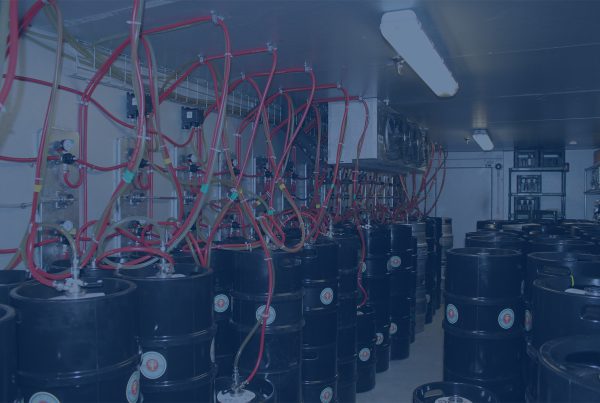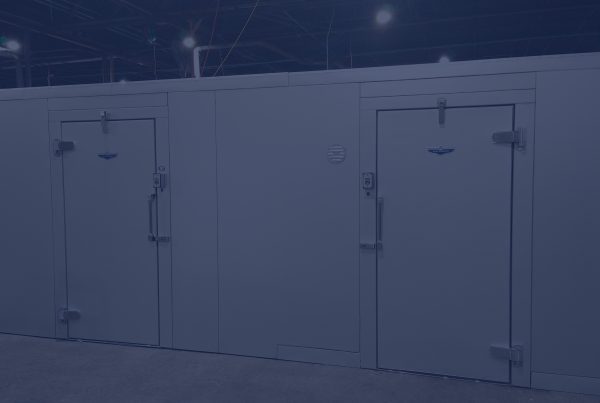Refrigeration systems consist of a condensing unit and an evaporation coil. The condensing unit is located outside the walk-in and the evaporator is located inside the walk-in. The compressor compresses gas to a liquid. The liquid is then pumped through the condensing unit coil while a fan blows outside air through the coil. Gas is condensed to a liquid and is then pumped through a small copper pipe into the walk-in to the evaporator coil. There, through the expansion valve located in the evaporator coil the liquid is allowed to expand back into a gas. The expansion of the liquid to a gas causes a rapid chilling of the evaporator coil. Since heat always flows toward cold, inside the walk-in air is blown across the evaporation coil to let the coil absorb heat from inside the walk-in. The gas is then allowed to exit the walk-in through a larger copper pipe to the condensing unit where it is once again compressed and cooled to a liquid state and returned to the evaporator coil inside the walk-in. There the cycle is started over.
The new EISA law requires all new walk-ins be equipped with high efficiency motors to be compliant. These cost a little bit more but save you money in the long run. Some suppliers may try to sell you non EISA compliant refrigeration systems. To be compliant with the law and purchase the best lifetime value always ask for EISA compliant equipment.
Refrigeration System Types
1. Remote Systems – Remote systems are the least expensive systems to purchase. They consist of a condensing unit, evaporator unit and misc. parts such as expansion valve, site glass, dryer, pump down solenoid thermostat, and on freezers a timer and drain heater to install the system. They require the use of a licensed refrigeration installer since they are pumped down and charged with refrigerant gas on site. The installer will also charge for any other parts needed for the install such as copper pipe, pipe insulation, connectors, and electrical. They are less expensive systems to buy with the walk-in but may cost more over all depending on what the going hourly rate is with the installer and the cost of the parts he provides. They also provide an advantage by allowing the condensing unit to be located outside the building. There the condensing unit can dump its heat without adding extra heat to the building and air conditioning systems.
2. Pre-assembled Remote Systems – Pre-assembled Remote Systems are the same as Remote Systems except all the parts are shipped installed on either the condensing unit or the evaporator coil. Pre-assembled Remote Pre-charged systems come with the condensing unit, the evaporator coil and line set (copper pipes that connect the two units) charged with refrigeration gas. A licensed refrigeration technician will be needed to install the refrigeration system. These systems may or may not be less expensive depending on the cost of the system, the refrigeration service and electronics service charges.
3. Standard Top Mount – Top Mount Systems are self-contained refrigeration systems. They come with all parts, copper lines and refrigeration gases completely installed. A licensed refrigeration technician will be needed to install the refrigeration system. The only downside to these units is that the evaporator hangs down inside the walk-in taking up shelf space and head room in small walk-ins. Some units come with low profile coils that help but do not eliminate this problem.
4. Side Mount Refrigeration System – Side Mount Refrigeration Systems are the same as Top Mount Refrigeration Systems except they are installed on one of the wall panels with bolts that go through the refrigeration plug and wall panel and are attached with nuts on the inside of the walk-in. They also require that a condensation drain hose be connected to a drain nearby. A licensed refrigeration technician will be needed to install the refrigeration system. One downside is that you lose shelf space where the evaporation unit extends inside the walk-in.
5. Saddle Mount Refrigeration System – Saddle Mount Refrigeration Systems come completely pre-assembled on a bracket that is designed to be mounted over the top of one of the wall panels. These systems must be installed on a panel with slots cut in the top to allow the bracket to go through the wall. These systems are hung over the wall before the installation of the roof. A licensed refrigeration technician will be needed to install the refrigeration system. These units also have the evaporator coil that hangs from the top of the panel but it is more toward the top and doesn’t interfere with the shelving as much as a side-mount unit.
6. Penthouse Refrigeration System – Penthouse Refrigeration Systems are like Standard Top Mount Systems except they do not have an evaporator coil sticking down inside the walk-in. The air inside the walk-in is drawn up through the evaporator coil located with the condensing unit on top of the walk-in to be cooled. A licensed refrigeration technician will be needed to install the refrigeration system. These systems sometimes seem higher in upfront cost but when all things are considered including the fact that they are factory assembled and don’t take up space in the walk-in it is less expensive in the long run.
7. Roll Up Refrigeration System – Roll up Refrigeration Systems are much like Penthouse Refrigeration Systems except they are rolled up to an opening in the side of the walk-in and attached to the unit. One difference is that even though the evaporator coil is located outside the unit it takes up shelf space inside the walk-in because shelving should not be installed in front of the unit. A licensed refrigeration technician will be needed to install the refrigeration system.
Now that you know all about these units don’t let it be confusing. To simplify the selection of refrigeration system, first decide whether allowing the condensing unit to dump heat into the building is unacceptable. If it is then a remote unit is the correct choice. Whether it is pre-assembled pre-charged should be decided by evaluating the difference in cost of having it done in the field or at the walk-in plant.
If dumping the heat inside the building is not a concern then choosing a self contained side mount or top mount refrigeration system verses a penthouse or rollup refrigeration unit should be decided by how important the space in the walk-in is to you. If space is important then a penthouse unit is the choice. If space is not a big consideration then side-mount, top mount or rollup unit may be the choice.
Whatever the refrigeration system you chose it is important to check the efficiency of the unit and the manufacturer’s warranty to make your final choice.
For more walk-in information visit our buying guide.




please quote us a walk in cooler with the next features 25 meters of large 15 meters of wide and 3.5 meters of high. – 21 ºc of temperature. We need to have 3 doors in the 25 meters extension. The doors could be slice door. The walk in cooler is going to be installed inside of a warehouse